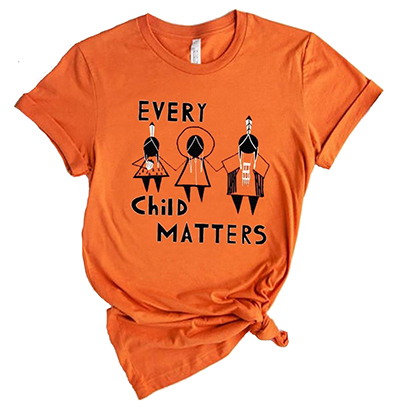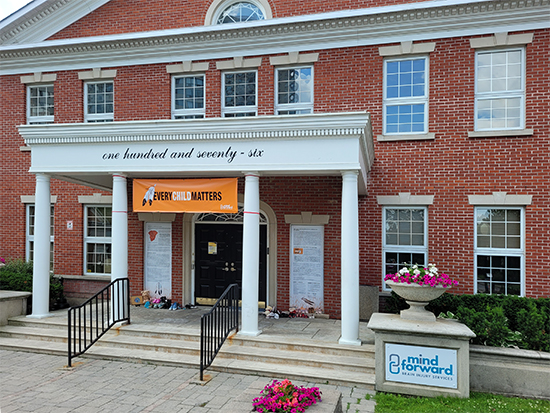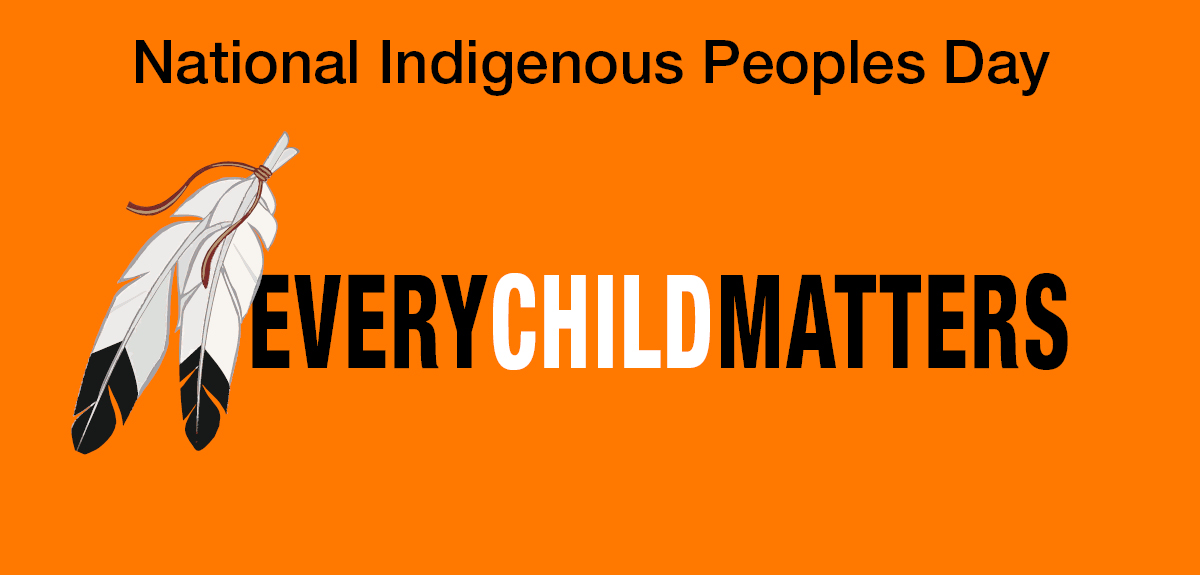
About the Artist: Shayne Hommy, a Grade 11 First Nation Cree student at South Peace Secondary School, in Dawson Creek.[1]
Residential schools in Canada
The residential school system was created by the Canadian government and administered by Christian churches with the purpose to assimilate Indigenous children into white, Euro-centric, Canadian culture. This system tore apart Indigenous families and communities. The effects of this system continue to this day, impacting generations of Indigenous families and communities.
Erin Hanson’s, a scholar from the University of British Columbia, research founded in settler-colonialism, the Crown consultation process, and Coast Salish law and jurisdiction over territory. In the publication “The Residential School System” they report,
“Residential schools systematically undermined Indigenous, First Nations, Metis and Inuit cultures across Canada and disrupted families for generations, severing the ties through which Indigenous culture is taught and sustained, and contributing to a general loss of language and culture.”[2]
The first residential school was the Mohawk Institute in Brantford, Ontario. It accepted the first boarding student in 1831. In 1951, the government began to transition from the residential school system to a “child welfare system”. [3] As a result of this, Indigenous communities were subjected to the “60’s scoop”, where government social worker agencies systematically removed Indigenous children from their homes, placing them into foster care, for white families to adopt. While residential schools started slowly closing starting in the 1950s, the last federally funded residential school in Canada closed in 1996, The Gordon Residential School in Punnichy, Saskatchewan. [4] Over the course of the 160 years that the
residential school system was in Canada, there were 130 residential schools operated in Canada.[5] Residential schools are very much a dark part of Canada’s history, recent past, and present.
Residential schools have been condemned for the tremendous abuse imposed on students in their “care”. Former students have spoken out about the physical, sexual, emotional and psychological abuse that they suffered at the hands of residential school staff, largely made up of members of the church.
The impacts of residential schools continue to effect the Indigenous community, through intergenerational trauma, loss of language, traditional teachings and spiritual wellbeing.[6] The oppression of Indigenous Peoples by Canadian society and government continues today in the form of land disputes, over-incarceration, lack of housing, child apprehension, systemic poverty, marginalization and violence against Indigenous women, girls and 2SLGBTQQIA peoples. [7]
Demanding Justice
Indigenous communities demand justice from the Canadian government, the churches, and all who participated in this colonial, assimilationist project. Despite years of allegations of abuse from Survivors, the Canadian legal system only began to address these allegations in the late 1980s. Even then, the response was inadequate with fewer then 50 convictions coming out of more than 38,000 claims of sexual and physical abuse. [8] In 1996, the Royal Commission on Aboriginal Peoples published a report on Indigenous communities’ and nations experiences with residential schools.[9] This garnered a lot of attention across Canada, and in Indigenous and settler communities. Based on the recommendations made by the Commission, the Canadian government publicly apologized to former students of residential schools. This was significant as the Government admitted their guilt in residential schools. In addition, the Aboriginal Healing Foundation was formed to support Indigenous communities in their journey to healing from the traumas inflicted by residential schools. However, for many people in Indigenous communities, this was not an adequate response to the harm inflicted. The residential school system has had lasting impacts on Survivors, and the Indigenous community. The main critique of these actions, were the lack of recognition of the ongoing harm and destruction to Indigenous communities.
In 2002, a National Class Action was filed on behalf of the former residential school Survivors and family members in Canada. As a result of this lawsuit, in 2005 the Canadian government and 80,000 Survivors reached the Indian Residential School Settlement Agreement, which included individual compensation for Survivors, additional funding to the Aboriginal Healing Foundation, and the creation of the Truth and Reconciliation Commission[10]. On June 11, 2008, former Prime Minister Stephen Harper issued a public apology, acknowledging the governments’ involvement in Residential schools and the lasting impact this has made in Indigenous communities. While the apology and acknowledgment by the Canadian government was a positive first step, this gesture needs to be followed by action to work towards reconciliation.[11]
The Truth and Reconciliation Commissions of Canada
To follow through with the Indian Residential Schools Settlement Agreement, the Truth and Reconciliation Commission of Canada (TRC) launched in 2008. The focus of the TRC was to create a national research centre, hosting national and community events, act as liaisons and collect data regarding Residential schools from the church and government, and complete a final report on the impacts of residential schools. [12] Despite the directive for the TRC coming from the federal government, the Commission faced many difficulties in collecting the necessary data to complete the final report. This included the TRC having to go through the courts on five separate occasions to obtain documents from the government and church pertaining to residential schools. The final report, Honouring the Truth, Reconciling the Future (year), documents the experiences of approximately 150, 000 Canadian residential school survivors.[13] The report detailed that 3,200 Indigenous children died of malnourishment, tuberculosis and other diseases caused by poor living conditions while in the “care” of residential schools.[14] Ojibwa judge, Justice Murray Sinclair, and an appointed commissioner for the TRC, reports that due to poor burial records, this number is likely much higher, “5 to 10 times as much.”[15] In the report, the TRC labeled the residential school system “cultural genocide” and was defined as “destruction of those structures and practices that allow the group to continue as a group”. The use of this term is important in acknowledging the harm done to Indigenous communities by the Canadian government. The TRC concluded: “these measures were part of a coherent policy to eliminate Aboriginal people as a distinct peoples and to assimilate them into the Canadian mainstream against their will.”[16] This summary concluded with 94 recommendations for the Canadian government to show their commitment to reconciliation, and the Canadian prime minister has committed to implementing them all. The Commission concluded in 2015, however, the National Centre for Truth and Reconciliation was founded at that time; its permanent home is at the University of Manitoba. This centre is responsible for continuing the journey of truth and reconciliation, and ensuring the government is held to account for the recommendations.
Orange Shirt Day and Every Child Matters
The St. Joseph Mission Residential School (1891-1987) Commemoration Project and Reunion events started Orange Shirt Day in May of 2013.[17] These events are a space for Survivors and their families to witness and honour the healing journey, and for Canadians to demonstrate their renewed commitment to the ongoing process of reconciliation. Orange Shirt Day is honoured on September 30th each year. This date was chosen purposefully as this is the time of year that Indigenous children were taken from their homes. This is also the beginning of the school year, and it is an opportunity for the education system to incorporate anti-racism policies for the coming year.[18] The significance of the orange shirt comes from a story by former student Phyllis (Jack) Webstad:
I went to the Mission for one school year in 1973/1974. I had just turned 6 years old. I lived with my grandmother on the Dog Creek reserve. We never had very much money, but somehow my granny managed to buy me a new outfit to go to the Mission school. I remember going to Robinson’s store and picking out a shiny orange shirt. It had string laced up in front, and was so bright and exciting – just like I felt to be going to school! When I got to the Mission, they stripped me, and took away my clothes, including the orange shirt! I never wore it again. I didn’t understand why they wouldn’t give it back to me, it was mine! The color orange has always reminded me of that and how my feelings didn’t matter, how no one cared and how I felt like I was worth nothing. All of us little children were crying and no one cared.[19]
In May of 2021, a survey of the grounds at the former Kamloops Indian Residential School uncovered the remains of 215 children buried on this site. Indigenous communities are advocating for a thorough investigation of all residential sites. Chief of the Federation of Sovereign Indigenous Nations Bobby Cameron is advocating for finding the children’s remains and giving them proper burials. This is an important step in supporting First Nations communities and families find closure. [20] The “Every Child Matters” movement is dedicated to bringing awareness of the abusive and dangerous conditions of Residential schools, and bringing light to the continuing effects of those who survived.
We recognize this moment, preceded by generations of harm, has been traumatic for many. If you need extra support, please consider accessing the following services and supports:
Survivors of the residential school system can get support through Canada’s Indian Residential Schools Resolution Health Support Program 24-7 crisis line by calling 1-866-925-4419.
Support is available for anyone affected by the lingering effects of residential schools. The Indian Residential School Survivors Society can be contacted toll-free at 1-800-721-0066.
From one settler to another: What are our commitments to healing, reconciliation, and truth?
As settlers and Health Care professionals, it is our responsibility to continue to learn, advocate for reconciliation and truth, and most importantly listen to Indigenous voices. Below, there are suggested
Where to donate:
Indian Residential School Survivors Society: https://www.irsss.ca/donate
National Centre for Truth and Reconciliation: https://give.umanitoba.ca/nctr
Legacy of Hope Foundation: https://legacyofhope.ca/home/about-us/
Orange Shirt Society: https://www.orangeshirtday.org/orange-shirt-society.html
Canadian Roots Exchange: https://canadianroots.ca/monetary-donations/
For more information on suggestions of where to support the Indigenous community please visit: https://www.ctvnews.ca/canada/how-to-support-survivors-of-residential-schools-1.5453277
Where to learn more:
The University of Alberta is offering an Open Online Course from the Faculty of Native Studies that explores Indigenous histories and contemporary issues in Canada. For more information please visit: https://www.ualberta.ca/admissions-programs/online-courses/indigenous-canada/index.html
For more resources please visit: https://www.rcaanc-cirnac.gc.ca/eng/1621448126309/1621448142223
For teaching resources please visit: https://www.orangeshirtday.org/teacher-resources.html
What to watch:
Angry Inuk: Alethea Arnaquq-Baril
We Were Children: Tim Wolochatiuk
Highway of Tears: Matthew Smiley
The Grizzlies: Miranda de Pencier
[1] https://www.orangeshirtday.org/shirts–gifts.html
[2] Hanson, E., Gamez, D., & Manuel, A. (2020, September). The Residential School System. Indigenous Foundations. https://indigenousfoundations.arts.ubc.ca/residential-school-system-2020/
[3] Hanson, E., Gamez, D., & Manuel, A. (2020, September). The Residential School System. Indigenous Foundations. https://indigenousfoundations.arts.ubc.ca/residential-school-system-2020/
[4] Hanson, E., Gamez, D., & Manuel, A. (2020, September). The Residential School System. Indigenous Foundations. https://indigenousfoundations.arts.ubc.ca/residential-school-system-2020/
[5] Miller, J.R., Marshall, Tabitha, & Gallant, David. (2021, June). Residential Schools in Canada. Canadian Encylopedia. https://www.thecanadianencyclopedia.ca/en/article/residential-schools
[6] Hanson, E., Gamez, D., & Manuel, A. (2020, September). The Residential School System. Indigenous Foundations. https://indigenousfoundations.arts.ubc.ca/residential-school-system-2020/
[7] Hanson, E., Gamez, D., & Manuel, A. (2020, September). The Residential School System. Indigenous Foundations. https://indigenousfoundations.arts.ubc.ca/residential-school-system-2020/
[8] Hanson, E., Gamez, D., & Manuel, A. (2020, September). The Residential School System. Indigenous Foundations. https://indigenousfoundations.arts.ubc.ca/residential-school-system-2020/
[9] The full report can be read here: https://www.bac-lac.gc.ca/eng/discover/aboriginal-heritage/royal-commission-aboriginal-peoples/Pages/final-report.aspx
[10] Hanson, E., Gamez, D., & Manuel, A. (2020, September). The Residential School System. Indigenous Foundations. https://indigenousfoundations.arts.ubc.ca/residential-school-system-2020/
[11] Hanson, E., Gamez, D., & Manuel, A. (2020, September). The Residential School System. Indigenous Foundations. https://indigenousfoundations.arts.ubc.ca/residential-school-system-2020/
[12] Moran, Ry. (2020, October) Truth and Reconciliation Commission. Canadian Encyclopedia. https://www.thecanadianencyclopedia.ca/en/article/truth-and-reconciliation-commission
[13] Moran, Ry. (2020, October) Truth and Reconciliation Commission. Canadian Encyclopedia. https://www.thecanadianencyclopedia.ca/en/article/truth-and-reconciliation-commission
[14] Moran, Ry. (2020, October) Truth and Reconciliation Commission. Canadian Encyclopedia. https://www.thecanadianencyclopedia.ca/en/article/truth-and-reconciliation-commission
[15] Moran, Ry. (2020, October) Truth and Reconciliation Commission. Canadian Encyclopedia. https://www.thecanadianencyclopedia.ca/en/article/truth-and-reconciliation-commission
[16] Moran, Ry. (2020, October) Truth and Reconciliation Commission. Canadian Encyclopedia. https://www.thecanadianencyclopedia.ca/en/article/truth-and-reconciliation-commission
[17] https://www.orangeshirtday.org/about-us.html
[18] https://www.orangeshirtday.org/about-us.html
[19] For more of Phyllis’s story please visit https://www.orangeshirtday.org/phyllis-story.html
[20] https://www.theguardian.com/world/2021/jun/01/calls-to-find-all-canadas-indigenous-mass-graves-after-grim-residential-school-discovery


